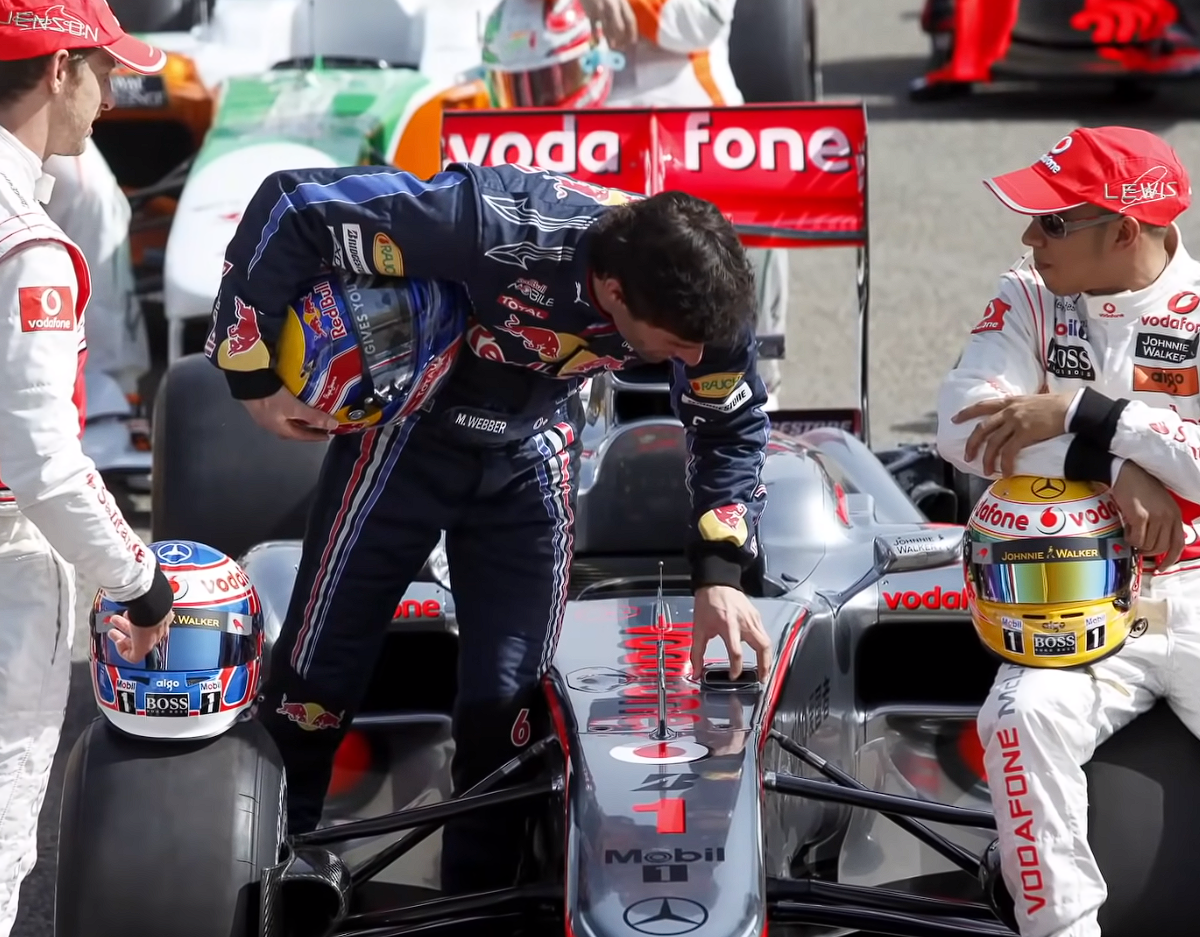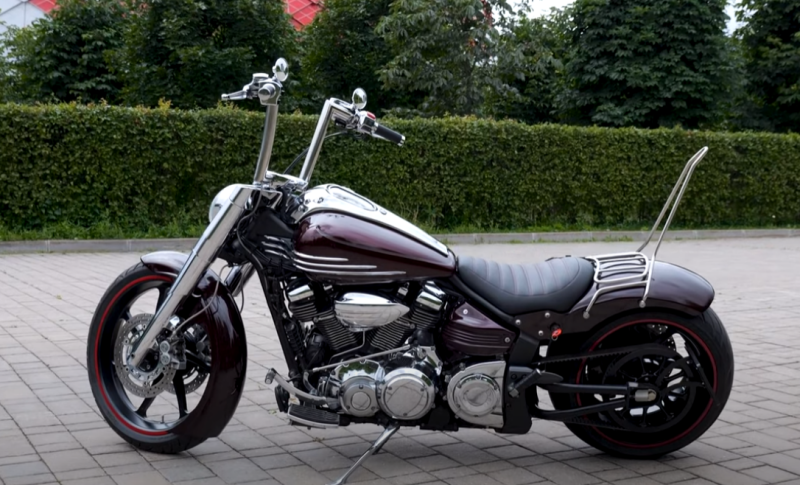high nose
In 1998, experiments in this area, such as the Tyrrell 025 or the Ferrari F310, stopped: the FIA introduced a standard for monocoques, prescribing basic dimensions and shape. By the way, because of this, the “semicircular” designs, like those of Jordan and Ferrari, also disappeared. Subsequently, the FIA changed the regulations for the bow more than once, and perhaps the “baboons” turned out to be the most amusing.
 Caterham CT05 with a funny nose. Photo: Youtube.com
Caterham CT05 with a funny nose. Photo: Youtube.com Now "high" nose cones are prohibited for safety reasons.
Keel
An inconspicuous, and seemingly unrelated detail to aerodynamics, in fact, had a huge, albeit indirect, effect on her. The keel is the attachment point of the lower front suspension arms to the monocoque. The higher you manage to raise them, the greater the volume of clean air can be sent to the area of the bottom and diffuser. In the course of development, two-keel schemes appeared in Formula 1, and later keelless ones. In the 2022 season, the arms are attached directly to the chassis, and although the regulations do not prohibit the keel, it is not used due to lack of space in this area.
 The cars of the current generation do not have a keel. Photo: Youtube.com
The cars of the current generation do not have a keel. Photo: Youtube.comSince we are talking about the suspension, it is impossible not to mention the clearance control devices. In addition to the obvious advantages, such as a constant ground clearance, which means stable clamping, the active suspension had one more property - thanks to it, the speed of the car on the straights was increased! How it worked: When going into a straight line, the rear suspension “squatted”, limiting the flow of air to the diffuser. As a result of the stall, the air resistance dropped and the speed of the car increased. Last season, this theme was continued: on the frames from the Mercedes-Benz on-board cameras, one could clearly see that the W12 suspension squats at a certain speed. This was done for the same purpose - to reduce drag.
This year, squat suspensions, except for the jumping "kangaroos" from Mercedes-Benz and Ferrari, are prohibited.
Front side deflectors
First introduced in 1993 on the McLaren MP4-8, these devices were designed to remove the "dirty" air around the front wheels from the bottom of the car. For the first time, similar devices were used back in the mid-eighties, but then they forgot about the deflectors, as the engineers found a way to divert turbulent air from the front wheels using elongated “endplates” located under the front wing. Nevertheless, the benefits of using these “screens” turned out to be significant: first McLaren, then Benetton, and then all Formula 1 cars got such devices.
 Graphics explaining the principle of the deflectors. Source: Youtube.com
Graphics explaining the principle of the deflectors. Source: Youtube.comThe development of deflectors continued with varying degrees of success until last year. Devices in this area are banned this year.
Bottom and side pontoons
Of course, no one forbade the bottom and pontoons. But there are many restrictions in this area. Firstly, during the 1994 season, the flat bottom, which had been used since 1983, was banned, first by installing a “slip board” that controlled the clearance, and a year later by introducing a “step”, which has survived to this day.
Secondly, in 2007, the Ferrari and BMW-Sauber teams developed and began to use the "flexible bottom". At a certain speed, the splitter between the Ferrari and BMW would lower, partially blocking the air flow under the car. This led to a decrease in air resistance, "turning off" the diffuser, and hence to an increase in the speed of the car.
 BMW Sauber F1.08 - a guide to the study of prohibited elements in Formula 1! Photo: Youtube.com
BMW Sauber F1.08 - a guide to the study of prohibited elements in Formula 1! Photo: Youtube.comBoth designs passed the FIA checks and were considered legal, but the McLaren team initiated proceedings in this regard, and during the season the FIA tightened the methodology. Since then, the flexible bottom has been banned.
Thirdly, let's mention the Ferrari F92A with a "double floor". This concept was developed by Mizho and Postlethwaite, and in theory such a design would increase downforce. But in the end, the idea didn't work. The double floor returned 15 years later, on the Toro Rosso STR6 car, and then it turned out that the concept's shortcomings were:
✅ Increased center of gravity
✅ High weight
✅ Low cruelty
✅ The complexity of the layout of the cooling system
outweigh the benefits. There were no separate restrictions on such an interpretation of the rules, and it was believed that double bottoms had sunk into oblivion. But in the spring, the Mercedes-Benz team introduced the concept of a "car without pontoons", which theoretically gives the same advantages as a double floor.
 There are practically no side pontoons on the Mercedes W13. Photo: Youtube.com
There are practically no side pontoons on the Mercedes W13. Photo: Youtube.comSince this season, the concept of the bottom has been revised - the ground effect, which has been banned for forty years, has returned to Formula 1, which means that what the teams have been working with for this time has turned out to be useless.
Middle wing
The debut of this aerodynamic element took place in 1995, on the McLaren MP4-10 already mentioned above. This winglet was originally intended to compensate for the loss of downforce due to the introduction of a "stepped bottom". The idea was picked up by Gary Anderson, but Jordan only used the middle wing once, in Monaco.
 McLaren MP4-10 is interesting not only for the middle wing, but also for the subsequently banned “needle” nose. Photo: Youtube.com
McLaren MP4-10 is interesting not only for the middle wing, but also for the subsequently banned “needle” nose. Photo: Youtube.comAnd although no one officially banned this wing, it disappeared from Formula 1. True, not for long. The middle wing first made a comeback on the 1999 Jordan, then reappeared on the Williams the following season. Later, in the form of "horns", on the 2005 McLaren, and in 2018 in the form of a T-wing on all Formula 1 cars. Placement of elements in this area is currently prohibited.
F-duct and S-duct
The first one is crazy stuff, but it worked! In certain driving modes, the air from the front of the car, through a special air duct, was directed to the lower plane of the rear wing. Moreover, under normal conditions, air entered the cockpit, so to activate the “air duct”, the pilot blocked a special hole with his hand, after which the air directly got to the rear wing.
 Schematic of F-duct McLaren. Source: Youtube.com
Schematic of F-duct McLaren. Source: Youtube.com F-duct worked on the principle of stall, leading to a decrease in the efficiency of the wing. That is, like the "flex bottom" or "squatting suspension", increasing the speed on the straights! These "air ducts" were used for a short time, since the method of their activation was recognized as dangerous.
Unlike the previous one, the S-duct, which debuted in 2008 at Ferrari and became widespread in 2012, is located in the front of the car, and is designed to divert "dirty" air from under the nose of the car to the top of the monocoque, where it is from turbulent air no big harm. S-duct continues to be used this year.
Coanda effect
After the introduction of restrictions on the placement of exhaust pipes, the effect of the "blowing" diffusers was reduced to zero. And then in Formula 1 they remembered the Coanda effect. In short, it allows the gas or liquid exiting the nozzle, in our case the exhaust pipe, to be deflected to the nearest surface and stick to it, which means that the exhaust gases were again used to "blow" the diffuser. Since 2014, such tricks have been banned: the location of the exhaust pipes is strictly regulated.
 Computer graphics explaining the Coanda effect. Source: Youtube.com
Computer graphics explaining the Coanda effect. Source: Youtube.comWithin the framework of a separate article, it is impossible to talk about all the aerodynamic devices of Formula 1, so the following remained outside the review:
✅ Candelabra or X-Wings
✅ mass dampers
✅ Flexible Wings, Shark Fins, Twin Towers & Dumbo Wings
✅DAS
✅ double and blown diffusers
All of the above technical solutions are also of great interest, and we will definitely consider them in more detail in the near future.
Over the past thirty years, we have seen an endless series of all kinds of restrictions. During this time, the designers came up with, and the officials banned, a huge number of all kinds of elements of aerodynamics. Of course, “arms control” is necessary, because without it, modern Formula 1 cars would be able to go into space! Just kidding, of course, but the fact that without these bans, pilots would need anti-g suits and catapults, we can say with confidence. But many of the presented technologies were also really dangerous for the riders, the same F-duct.










